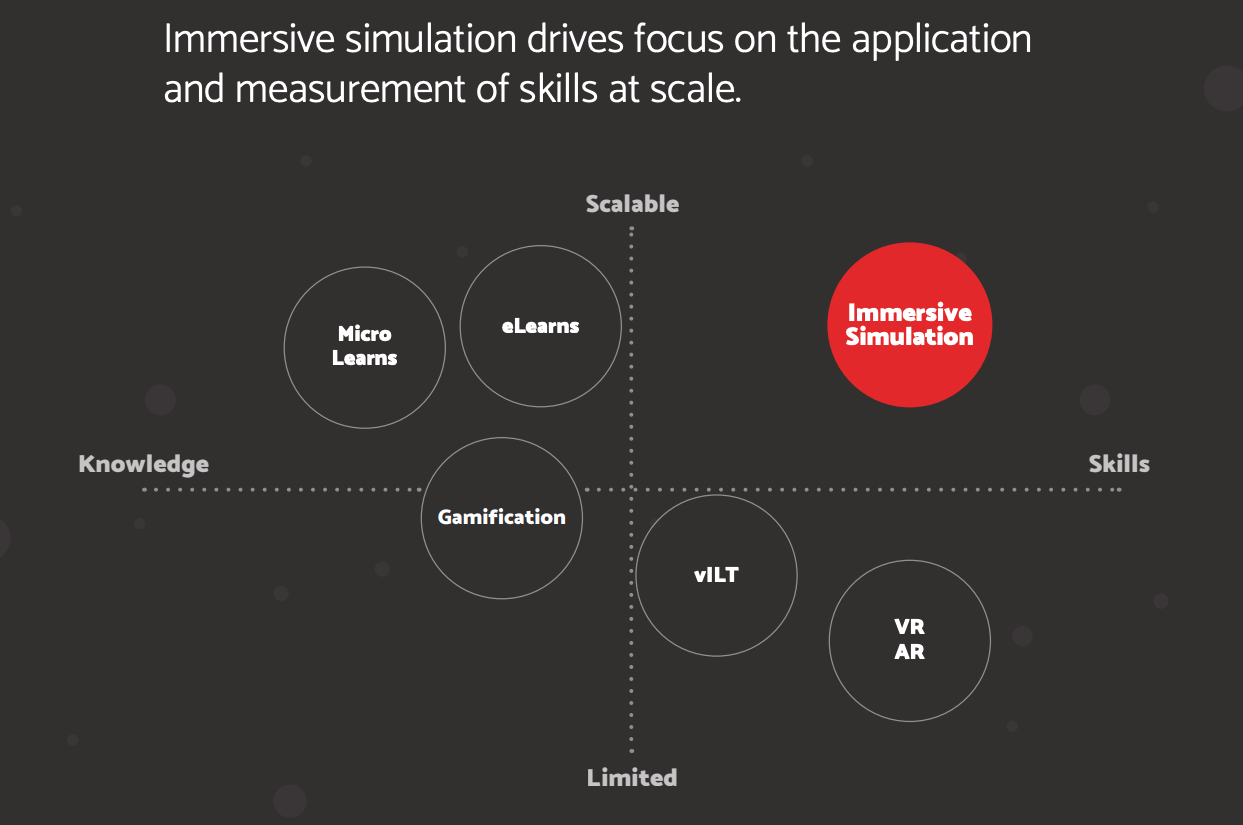
Immersive learning for corporate training: The complete guide
An in-depth look at why using immersive learning for corporate training can bring huge impact and ROI, and often without the need for any new hardware.
Our complete guide to immersive learning covers:
- What is immersive learning?
- Types of immersive learning
- Immersive learning benefits
- How to create an effective immersive learning program
As immersive learning takes center stage in many corporate learning strategies, its fast-growing momentum warrants a close look at the popular types of immersive learning and the benefits they each bring. In this definitive guide to immersive learning, we also share best practices for getting started with a program to meet your business needs and training goals.
What is immersive learning?
Immersive learning is an experience that puts the learner into an interactive environment without any distractions. It’s as close as possible to a real-world situation, and usually drops the learner into a first-person role that replicates a workplace scenario. Emotions, action, tension, and ambiguity are usually projected on a learner during immersive learning. The goal is to maximize learner engagement.
Within corporate training, scenario-based learning has long been used to learn new skills and practice through role-play. It is particularly powerful for practicing essential soft skills such as sales, customer service and leadership.
While training scenarios were traditionally used within peer to peer buddying systems or team-building days, as fast internet and access to computers have become ubiquitous, the term immersive learning is now associated with technology based solutions like AR / VR, 360 degree videos and simulations.
Types of immersive learning
The most common types of immersive learning can be organized into four broad categories:
- 360 degree images and video
- Scenario-based learning
- Immersive simulation
- Extended reality (XR), which is an umbrella term used to describe virtual reality (VR), augmented reality (AR) and mixed reality (MR)
Each mode of immersive learning has its own set of pros, cons and best use cases.
Table: Comparing immersive learning types
* Depends on the nature of the image/video/experience
** Depends on the nature of the experience. For example, is a pre-designed path in place for the learner or can they branch into different scenarios?
*** Further research needs to be completed into the practical scalability of XR
360 degree images and videos
360 degree images and videos can be relatively low cost and easy to create. They enable trainers to give their learners a richer understanding of a working environment than text or audio instructions alone, and can appeal to a wide variety of people and learning preferences.
There are many professionals who have the skills to work with an L&D team to create high-quality, engaging 360 degree image and video content.
However, use of images and video are at the lowest end of interactivity and do not offer the opportunity for learners to develop through practicing skills or experimentation. The learner is not placed within, or in control of, the learning experience, so can never truly get into a state of flow for maximum engagement, immersion and active learning.
360 degree images and videos are well-suited for company onboarding training where it’s helpful for learners to gain an understanding of their physical working environment and expected practices in the context of their role. It is often embedded within elearning content to enrich the experience.
Scenario-based learning
Scenario-based learning can be done in a high, low or even zero-tech way. In many ways, scenarios form the basis of other immersive learning methods, as they allow the learner to imagine or experience the real-world setting.
However, when done in groups or with a peer, it can lack the self-direction and psychological safety that comes with being able to access learning materials 24/7 at a time and place that suits the learner, and with the space to practice and make mistakes when nobody’s watching.
Face to face scenario-based learning is restricted in terms of the number of hypothetical scenarios a group of people can create for the benefit of an individual learner, making it difficult to personalize the experience for an individual.
Scenario-based learning tends to be used most powerfully for sales and customer service training, where the learner will be required to tailor their behaviors and responses to the person or people they are interacting with.
Immersive simulation
Immersive simulation uses multimedia technology to replicate a live working environment and hypothetical scenarios. It does not require hardware such as the headsets associated with VR / AR, but enables a high degree of interaction via a PC, mobile or tablet device.
The key to immersive simulation is feedback. The training draws the learner into a scenario and requires interaction such as typed, spoken or multiple choice responses, or choosing a movement within the virtual environment. Scores, suggestions and guidance can be offered live or at the end of any scenario so that positive outcomes reinforce new knowledge / skills. The learner can also correct course if potential improvements are highlighted.
The fact that immersive training simulations can run a computer or mobile device means that learners will usually already have the hardware required. As simulations can be rolled out, and usually accessed in a browser, they are hugely scalable and can be designed to be fully accessible (e.g. WCAG 2.1 AA compliant). Once training content has been created with the capability to generate many scenarios, it can be delivered to any number of learners in any location, at virtually no additional cost.
The main downside of immersive simulation is that it requires a high level of expertise to create. Multiple skill sets need to be brought together - L&D / instructional design, video development, graphic design, subject matter expertise and software development. Few companies have the ability to develop immersive simulation in-house. Fortunately Learning Simulation Platforms (LSPs) have been developed to simplify the end-to-end production and delivery of the experiences.
Immersive simulation can be extremely powerful for soft skills training in corporate environments where drawing on knowledge and experience while demonstrating soft skills is essential. This makes immersive simulation ideal for leadership & management training and diversity, equity & inclusion (DEI) programs in particular. It is also highly effective as part of onboarding, compliance & risk management, and sales / customer service training - especially where learners are based across multiple locations. Because skills in these different areas can be measured as a learner progresses through a simulation, immersive sims are a good option for organizations that want to personalize and track skills data.
Immersive simulation is often the best choice for companies that want to maximize the effectiveness of critical skills training, while accessing learning analytics to measure performance and drive continuous improvement.
Extended reality
Extended reality (XR) is what often springs to mind when people use the term ‘immersive learning’. It requires additional hardware in the form of a headset to create a virtual reality (VR) environment or eyewear for augmented reality (AR). XR also includes the full simulation experience that many people might associate with racing car or aircraft simulators.
In addition to the learning content that can be created for immersive simulation, XR engages full or partial use of the learner’s body. This makes it ideal for safe practice of manual skills, such manufacturing processes, medical procedures and of course - driving and flight.
The two main downsides to XR are cost and scalability. Learning design and software development costs can be dwarfed by the hardware needed to deliver them.
As every learner needs access to the appropriate hardware, it can be impractical to use XR for learning beyond essential training in high-consequence technical and manual skills, so it is rarely used by knowledge workers.
Also, when it comes to critical skills training, the existing XR solutions do not currently offer objective skill measurement that is needed to identify skills gaps and direct further learning.
XR is well-established in, and the best mode of immersive training for high-consequence industries like oil & gas, healthcare, aviation and the military.
Further reading: we commissioned research by Learnovate, the research team at Trinity College Dublin, on best practices for selecting immersive learning technologies to suit your training needs.
Immersive learning benefits
Active, immersive learning has been shown to be a far more effective learning method than passive reading, listening or watching. Numerous studies like this research from the National Academy of Sciences have demonstrated measurable, true learning from active engagement, whereas passive learning brings a weaker, mere ‘feeling of learning’ that is less retained over time, and less transferable to live situations.
Some specific benefits of immersive learning include:
Employee engagement and retention
The closer training is to the context of a learner’s role, the more engaged the learner becomes. Immersive learning drops a learner into highly relevant situations, where a learner naturally wants to engage and respond.
Companies are able to greatly increase employee engagement and retention by choosing the right mix of training opportunities for its workforce, as seen in this report from LinkedIn Learning.
In fact, companies that excel in this area have been found to nearly double the average employee retention span, from 2.9 years to 5.4.
Great training should be seen as both an investment in talent and a way to cut recruitment costs, as employee turnover can be reduced.
Genuine learner engagement is difficult to track through surveys or conversations with learners, as often they will have a blanket attitude towards training as a whole.
How the user interacts with immersive learning though - what they delve into, skip over, repeat or ignore - gives data on what is engaging or boring, too easy or too hard.
User engagement data can greatly inform future training investment decisions.
Personalized learning
The data generated during technology-enabled immersive learning and assessments give insights into team progress, but also analysis of individual performance. This offers opportunities for personalized learning through interventions from HR or L&D teams or with pathways generated automatically by the learning or simulation platform.
Every person has their own strengths and weaknesses, so by leveraging the data, companies can customize the learning pathway for each employee.
Psychological safety
When employees are offered immersive learning that’s accessible at a time and place that suits them, they can have a safe space to practice, experiment and fail without negative consequences. This freedom, advocated most famously by L&D at Google, is known as psychological safety.
Instant learning and assessment feedback within the immersive simulation platform itself means that the learner can self-correct and find what works for them, without the pressure of formal assessments that can stifle effective learning.
Learning analytics
Peter Drucker is quoted as saying - “What gets measured gets managed.” While there are both advocates and opponents of this philosophy, where performance data is important, technology-driven immersive learning makes learning analytics possible for the L&D team.
Traditional knowledge assessment in the way of quizzes and multiple-choice questions give an idea about an employee’s knowledge at any one point in time. However, they can be a poor predictor of skill application in a real-world-setting. As we know, ‘book smarts’ don’t always correlate with performance.
Active learning and scenario-driven immersive learning approaches offer endless potential data points and potential for skills development.
Analysis of a learner’s real-time choices and behavior enable L&D managers or the immersive learning system itself to provide instant feedback in context, rather than just a raw number score at the end of a test.
The sharing of data is made easy, so that managers can link knowledge and skills demonstrated with learning to performance in a role. This means that opportunities for coaching or further development, and potential superstars and leaders can be identified.
In order to improve both training content and learner support, L&D or HR teams should laser in on data related to:
- Skill improvement - which learning assets are contributing to the greatest skill improvement in learners
- Frequency of access - how often is training content used or revisited by an individual or a group?
- Engagement with content on which types of content are used more than others can give insights into what training is proving useful.
- Attrition - quickly see content or environments that are confusing or in need of improvement.
Scalability
The immersive learning benefits are clear, so why isn’t all learning created to be immersive? Well - it has historically been more resource intensive.
VR and AR require each learner to have the appropriate hardware in the form of a headset or eyewear, which can get prohibitively expensive if you’re training hundreds or thousands of employees. The hardware may be overkill for soft skills training where experiential learning within a certain physical environment isn’t necessary.
Even virtual instructor-led training (vILT) conducted via Zoom or Microsoft Teams requires hiring a trainer, and learners to be taken away from their day to day work as a group - all expensive and disruptive. In a nutshell - it isn’t scalable.
 Books, and more recently elearning, are scalable of course, but have lacked immersion.
Books, and more recently elearning, are scalable of course, but have lacked immersion.
In particular, modern immersive simulations enable training content to be created once and rolled out to any number of learners in any location - and often with little additional cost. This offers complete scalability.
How to create an effective immersive learning program
Many L&D leaders are enthused about the potential of immersive learning but daunted by the prospect of making poor choices or over-investing their budget if a program was to fail.
With the right decision-making process and by calling on the right experts though, investment in immersive learning doesn’t need to be daunting.
Here are some quick tips on how to create an effective immersive learning program that will deliver maximum stakeholder buy-in, learner engagement, positive outcomes and training ROI:
- Set clear goals. L&D managers do this anyway at the start of a new training program, so introducing immersive learning technologies should not change this habit. What do you want to improve by introducing immersive learning and how will the success of the program be measured?
- Choose the best mode of delivery. As discussed above, there are 4 broad categories of immersive learning, each suited to different industries, budgets and skill areas. If you want to roll out diversity training to thousands of employees across the globe, with content easily updated, VR headsets for everyone is probably neither practical nor a value-add.
- Work with experts. If you don’t have subject matter experts in-house, there are consultants available to support every sector with every type of training need. When it comes to working with an immersive learning solution provider, contact one that is proven in supporting a company of your scale with your type of training need - ideally in your sector.
In summary
In the race for top talent, maximizing their performance and potential, and increasing employee engagement and retention, training is increasingly seen as a competitive advantage. Those that are doing it well are attracting and retaining the best people and are consistently shown to be more profitable.
Immersive learning is at the forefront of modern training, so by leveraging its many benefits, it could give your company a game-changing edge.

